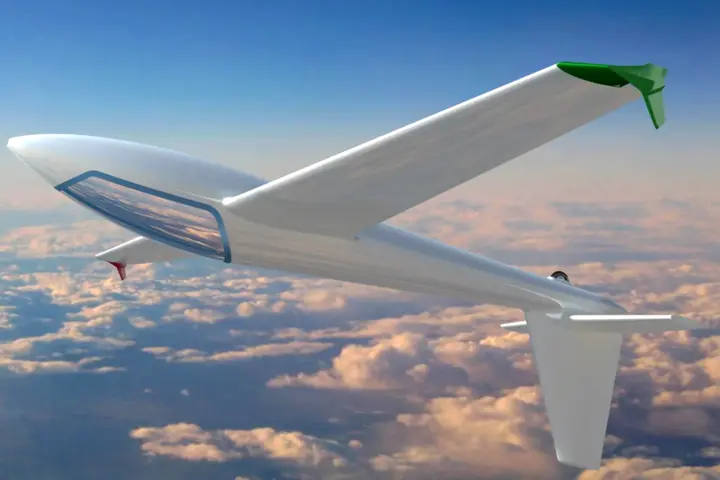Major hurdles for a special glider
Joscha Löwe has been a member since 2018, making him an "old hand." He started out studying mechanical engineering before eventually switching majors to medicine. Nevertheless, he still finds the time to work on Akaflieg München's Mü-32 "Reißmeister," at times even taking the lead on the project – one that Kistler is also involved with: "With the Mü-32, we want to build an aerobatic glider that improves on the Mü-28. In particular, we want to achieve better performance during stalling, increase crash safety, and install an automatic plain flap – and all at extremely high loads of up to 10 g and high speeds of up to 320 km/h!" In order to receive approval from the Luftfahrt-Bundesamt (the German Federal Aviation Office), they will have to clear major hurdles to prove that the aircraft can withstand the anticipated load many times over. This means destructive wing testing is required during which the sophisticated carbon-fiber wing will be loaded in a controlled manner at a prescribed temperature of 54°C.
Measurement technology tailored to destructive wing testing
In addition to the wing itself, whose construction involved a great deal of detailed manual work, the destructive wing test, which was carried out in the LPL Lab in Garching and streamed live on YouTube, also required appropriate suspension with load shears and suitable measurement technology. Clemens Lippmann, who is currently pursuing a master's degree in Astrophysics and is also close to completing his glider pilot's license, picks up where Löwe left off: "In addition to high-speed cameras, we also use a force link from Kistler and 35 strain gauge sensors as well as rope displacement transducers and temperature sensors. All of these sensors are connected to the data acquisition system KiDAQ, which was provided to us by Kistler as a solution that is precisely tailored to our tests." The force link 9377D, a triaxial, preloaded piezoelectric force sensor with a high degree of sensitivity and a measuring range of up to 150 kN, is installed on the tip of the load suspension system between the steel girders and the crane connection and is connected to KiDAQ. Thanks to the modular design of this DAQ system from Kistler, all of the sensors can be connected with KiDAQ regardless of manufacturer – including automatic synchronization via precision time protocol (PTP).
Akaflieg München first came into contact with Kistler in 2021 through the Münster-based company CTS crashtest-service, one of Kistler's partners in the field of crash testing. At that time, Akaflieg München was hard at work developing an innovative crash cockpit for gliders and, in particular, the future Mü-32, as part of its "CraCpit" research project. The final crash test used a dummy instrumented with measurement technology from Kistler along with the data acquisition system KiDAQ. During this test, Lippmann and a colleague from Akaflieg Hannover became aware of the software jBEAM, which greatly simplifies the evaluation of measurement data from tests and measurement technology applications: "With jBEAM, Kistler provided exactly what we needed while also saving us a great deal of tedious programming work in Python," continues Lippmann. "Another extremely valuable asset, 10 out of 10 so to speak, was the dedicated support we got here on site from Martin Schlierf and Wolfgang Ziehers, who helped a great deal with the measurement technology and calibration."
Failed destructive wing test: Why did the wing break so quickly?
On April 18, 2024, after more than a year of preparation, the time had finally come: Live on the internet and in front of many interested engineers, university students and staff, and alumni of the organization, the destructive wing test was expected to go off without a hitch. The wing was heated to 54°C and then gradually subjected to a greater load – until it unfortunately broke after just a few seconds, far below the targeted maximum load (factor 1.61; a factor of 2 is required). "To this day, we do not know for sure why it happened," says Löwe. "There was no single factor that we could determine to be the cause. The most likely answer is that the test setup was not sufficient and that we will need to use more load shears in order to properly distribute the force or optimize the bend line. We are still comprehensively analyzing the data from all of the sensors and cameras using the measurement data analysis software jBEAM from Kistler, which is extremely powerful and practical in terms of evaluation, especially when it comes to importing and exporting data."
Measurement technology from Kistler to be used for the next destructive wing test
Once the causes have been determined and an alternative plan developed, it will be time for the active members of Akaflieg München to start the testing process all over again. After all, without a successful destructive wing test, the wings cannot be approved, which would mean no new Mü-32 aerobatic glider. At the moment, the planning phase is scheduled to last until 2028 or even 2030 because, in principle, the students were back at square one when the first test failed – and they also need to manage the constant fluctuation in terms of active personnel.
The team is also planning to use additional measurement technology for the second destructive wing test, for example additional force links from Kistler, even more strain gauge sensors on the wing, and possibly even an optical measuring system in order to precisely track the deformation on the wing. In conclusion, Joscha Löwe says: "The measurement technology from Kistler has very much proved its worth, so much so that we will definitely be using it again in the future – if necessary also in the form of additional sensor technology for the Mü-32 flight tests, even if we have a long road ahead."






